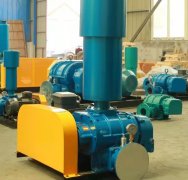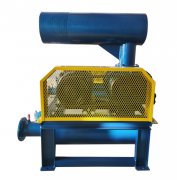High temperature during the operation of Roots blower is a common fault, which may be caused by various factors. The following is a systematic analysis of the reasons and solutions:
---

**1、 Common causes and solutions**
**1. Lubrication system issues**
-* * Reason**
-Insufficient lubricating oil or low oil level
-Lubricating oil deterioration (oxidation, impurities mixed in)
-Lubricating oil model does not match (viscosity too high or too low)
-* * Processing**
-Check the oil window and replenish to the standard oil level (1/2~2/3)
-Replace with qualified lubricating oil (recommended ISO VG68 or VG220, according to the manufacturer's requirements)
-Clean the fuel tank and oil circuit
**2. Abnormal mechanical friction**
-* * Reason**
-The rotor clearance is too small or the impeller friction shell
-Bearing damage (wear, lack of oil)
-Poor gear meshing or wear
-* * Processing**
-Adjust the impeller clearance to the standard value (0.2~0.4mm)
-Replace bearings (pay attention to installation accuracy)
-Check the gear meshing marks and replace worn gears
**3. Excessive system resistance**
-* * Reason**
-The outlet pipeline is blocked or the valve is not opened
-Filter (inlet/muffler) blockage
-Actual working pressure exceeds the rated pressure of the fan
-* * Processing**
-Clean up foreign objects in the pipeline and fully open the valve
-Clean or replace the filter element
-Check the system design pressure and replace the high-pressure model fan if necessary
**4. Poor cooling**
-* * Reason**
-The ambient temperature is too high (>40 ℃)
-Dust accumulation on heat sink/cooling fan
-Insufficient or blocked cooling water for water-cooled fans
-* * Processing**
-Improve ventilation conditions and install forced exhaust
-Clean the dust on the heat sink
-Check the cooling water flow and clear the pipeline
**5. Electrical issues**
-* * Reason**
-Motor overload (unstable voltage, phase loss)
-Poor alignment of the coupling results in additional load
-* * Processing**
-Check voltage and current, repair circuit
-Re calibrate the concentricity of the coupling (error ≤ 0.05mm)
---
**2、 Temperature judgment criteria**
-* * Normal range * *:
-Bearing temperature: ≤ 70 ℃ (can be briefly touched by hand)
-Shell temperature: ≤ 80 ℃ (ambient temperature within+40 ℃)
-* * Danger threshold * *:
-If the temperature exceeds 90 ℃, the machine should be stopped immediately for inspection
---
**3、 Emergency handling steps**
1. * * Immediately shut down * * and cut off the power supply.
2. * * Investigate explicit faults * *:
-Check the oil level, belt/coupling, and inlet/outlet pressure.
3. * * Manual turning * *: Confirm if the rotor is stuck.
4. * * Gradually eliminate * *:
```mermaid
graph LR
A [High temperature fan] -->B {Normal oil level}
B -->| Yes | C [Check bearings/gears]
B -->| No | D [Add or change oil]
C -->E {Mechanical Friction}
E -->| Yes | F [Adjust gap or replace parts]
E -->| No | G [Check system resistance]
```
---
**4、 Preventive measures**
-* * Regular maintenance * *:
-Check the condition of the lubricating oil every 3 months and replace it annually.
-Clean the filters and heat sinks monthly.
-* * Operation monitoring * *:
-Install temperature sensor and set alarm value (such as 85 ℃).
-* * Selection optimization * *:
-Choose heat-resistant fans or install cooling systems in high-temperature environments.
---
**5、 Special case**
-Transporting corrosive gases:
-Corrosion inside the shell causes friction heating → Choose stainless steel or fluorine lined fan.
-Frequent start stop:
-The rotor undergoes repeated thermal expansion → reduce the number of start stop cycles and install a frequency converter.
---
**Tip: If the above methods are ineffective, it may be due to severe internal wear (such as impeller deformation), and it needs to be returned to the factory for repair. Suggest keeping records of fan operation (temperature, current, pressure) for fault analysis!



